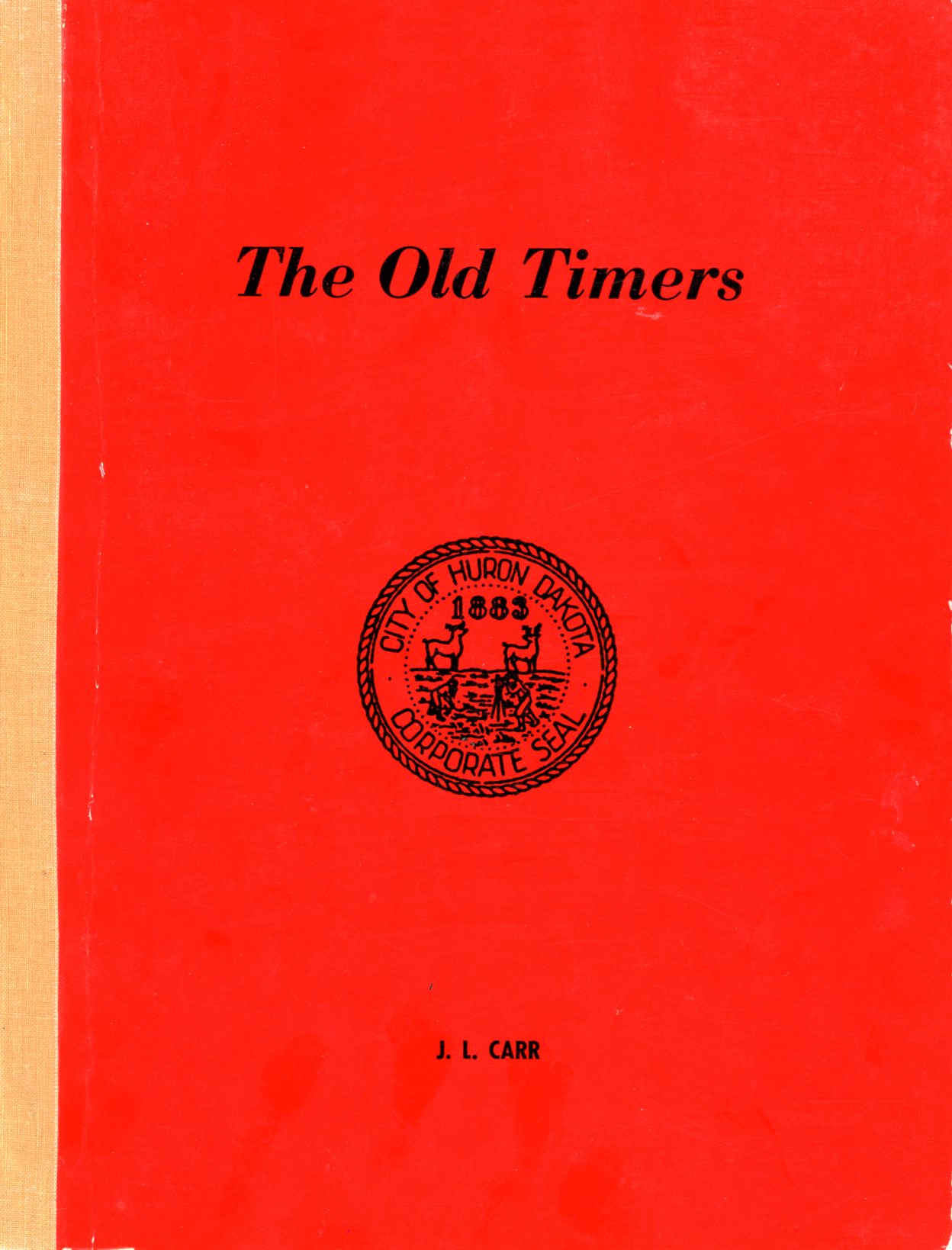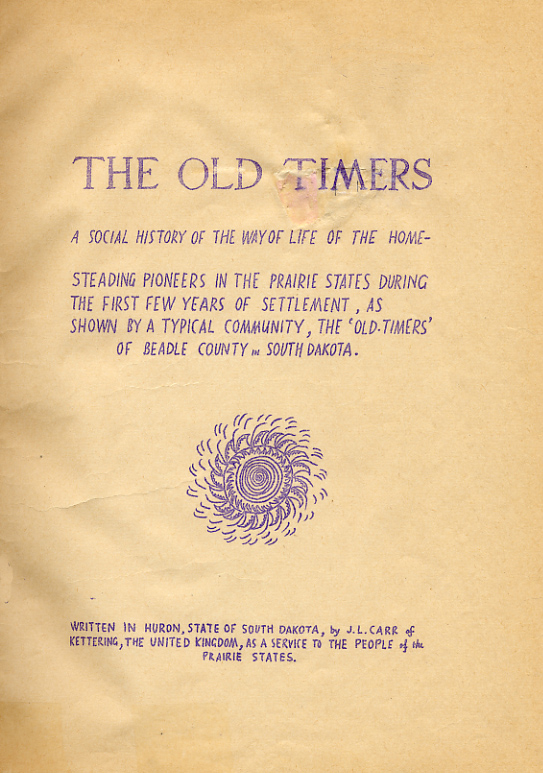The Old Timers
Carr wrote, illustrated and printed this book during his second visit to Huron (pop 15,592 in 2010), South Dakota, where he taught at Huron High School from September 1956 to July 1957. In a copy of a letter in Kettering Library Carr wrote about what he did:
Whilst I was teaching in South Dakota in 1956/57 I wrote a social history ‘The Old Timers’ . . . It was a reconstruction of detailed accounts of the 1880 pioneers in Beadle County collected by a realtor (and a naturally born historian) Sherman Davis in 1935-38. I was teaching an earlier year in the same school in 1938, knew of his work, and eighteen years later, completed the job which death had prevented him from doing.
Carr reported that he printed 82 copies (see Articles: The Passport Interview
, 1991), and had them bound at a cost of $12. He said that he gave 40 copies to people who had helped or had lent him furniture during his stay (in a school-owned house on Ohio Avenue SW), and sold about 40 to local libraries (see below) for $2 each, which is roughly equivalent to $18 in 2018.
(Last updated on 27/3/2022)
H-TIM1: First and only edition
Title: The Old Timers.
Published: May 20th, 1957 (J.L. Carr's 45th birthday)
ISBN: none
Size: 210 x 175 mm
Printed by: mimeograph process on thin, acid paper
Edition: 82 copies (Carr, 1991)
Title page: THE OLD TIMERS. A social history of the way of life of the home-steading pioneers in the Prairie States during the first few years of settlement, as shown by a typical community, the 'Old Timers' of Beadle County in South Dakota.
Written in Huron, State of South Dakota, by J.L. Carr of Kettering, the United Kingdom, as a service to the people of the Prairie States.
Dewey Decimal Classification of library copy: 978.3.C23o
Original binding: red printed glossy card to front printed with title, City of Huron corporation seal dated 1883 (drawn by hand), and J.L. Carr, below; crimson paper to rear. Three staples and pale tape to spine. Two sheets of dark red card as rear covers.
Pagination: Parentheses means that the page number is missing while a gap in numbers means the page is missing:
Cover; title page; copyright page; ownership page; foreword; contents and acknowledgements; map of Beadle County; pages 1, 2, (3), (4), (5), (6), 7, 8, 9, 10, 11, 12, 13, 14, 15, 16, 17, 18, 19, 20, 21, 22, 23, 24, 25, 26, 27, 28, 29, 30, 31, 32, 33, 34, 35, 36, 37, 38, 39 (missing from one copy; present in another), 40, 41, 42, 43, 44, 45, 46, 47, 48, 49, 50, 51, 52, 53, (54 missing), 55, 56, 57, (58), 59, 60, (60A), (61), (62), 63, 64, 65; 2 pp index; 1 pp list of illustrations; endword; two sheets of card as rear cover. See notes, below.
Contents:
P1 Grass
P2 The Immigrants
P6 Filing a Claim
P10 Finding your Farm
P12 Pioneer Architecture
P14 Heating Systems
P17 Loneliness
P19 Water
P22 First Years' Farming
P27 Fire
P29 Hailstones
P31 Indians
P32 Cyclones
P35 Winter
P37 Blizzards
P40 Corpse Landing
P44 Travellers
P47 The Children
P51 A Gathering on the Prairie
P52 No Locks on the Doors
P55 Newspapers
Cover
Title page
Contents: continued
P57 How a City Started
P61 Women's Work
P65 Afterwards
Notes: Note that there is no page 54, at least in the two copies seen: the numbered pages go from 53 to 55. There are three un-numbered pages between pages 60 and 63, so one has been numbered 60A.
The two copies described here are in the original binding (which is missing page 39) and a re-bound copy de-accessioned from the Huron High School Library which has the Contents page bound in a different position.
There are copies of this book in 11 libraries in the USA:
- Pierpont Morgan Library, New York
- New York Public Library, New York
- University of Minnesota, Minneapolis
- Mikkelsen Library, Augustana University, Sioux Falls, South Dakota
- Brookings Public Library, Brookings, South Dakota
- Williams Library, Northern State University, Aberdeen, South Dakota
- Siouxland Libraries, Sioux Falls, South Dakota
- Hilton M. Briggs Library, South Dakota State University, Pierre, South Dakota
- South Dakota State Library, Pierre, South Dakota
- Rapid City Public Library, Rapid City, South Dakota
- Huron Public Library, Huron, South Dakota.
Only one copy has been located in a library in the UK, in Kettering Public Library, which is in the original binding. Although The Plainsman newspaper in Huron reported on 28th July 1957 that copies had been lodged with the British Museum, Oxford University and Cambridge University, these institutions do not have a copy.
One of the copies described here was from the library of the school at which Carr taught. It was excess to their requirements and was sold by the Friends of Huron Public Library to raise funds.
J.L. Carr's sketchbook of drawings for The Old Timers
is in the collection of the Dakotaland Museum (see below).
The book has been digitised by the Digital Library of South Dakota and can be seen here.
You can see a few paintings done by Carr of places around Huron, here.
This was published in The Daily Plainsman on 26 May 1957 in an article by Bob Lusk called The Publisher's Notebook
.
James L Carr, of Kettering, Eng., is about to complete his second year of teaching in Huron High School.
He will leave behind him for the people of Huron, Beadle County and the northern plains, a real contribution to the history of pioneering and pioneers living in this great region of America. For, during his spare time - in the early morning hours and after school until late at night - he has written, illustrated and put together in book form a record of the way of life of the plains homesteaders.
This is the text of a letter published in The Huron Plainsman newspaper on 23rd January 1958:
HISTORY SHOULD BE PRESERVED
To the Editor:
Both the new and old settlers of Beadle County appreciate the great contribution the late Mr. Charles Moore* made in organizing and preserving interesting facts about Beadle County History. His passing is a great loss to the community.
Many of the old settlers have expressed the regret that more is not being done to provide a suitable place for historical material such as Mr Moore collected. Such material can never be replaced and now is the time to plan for a room such as a Beadle County Memorial Room in the recently planned new library.
There are many pictures of old timers scattered around Huron. They need to be identified before it is too late. Stories of those first days in Beadle County need to be collected.
Without Charles Moore, Sherman Davis, the Rev. H. Ketelle and a few others, many records of value would have been destroyed. It took a man from England, Mr. James Carr, to realize what a rich and unusual heritage we have and to write about it.
The people of our county should take enough pride in our unique history to systematically preserve this important information. Mr Moore has given us a good start. Let us all unite and do something about it.
Mildred McEwen Jones, whose parents came in 1881.
Mildred McEwen Jones wrote and self-published a book in 1961 entitled Early Beadle County, 1879 - 1900, a book that Carr mentioned she was writing in The Old Timers.
An article in The Daily Plainsman on 1st October 1958, printed a letter from Carr.
Sir; I have only just heard of the death of my old friend Charlie Moore.* On and off in the last 20 years I spent a deal of time in his cellar listening with awe to his flood of talk seasoned with a rare collection of Anglo-Saxon expletives. . .
His knowledge of the recent history of Huron and district was encyclopedic and he had the foresight to collect together extracts from nineteenth century copies of The Huronite and had these typed. . .
In a decade when more and more of us are conforming to pattern, Charlie stubbornly stayed the last man in America to believe General Custer's end should be pinned on the Pentagon rather than the Sioux.
Farewell, old friend! Jim Carr.
* The Battle of Pollock's Crossing was dedicated to C.M. in his basement, R.I.P.
The Dakotaland Museum was established in Huron in 1960, dedicated to the preservation of the heritage of Huron and Beadle County. More than 15,000 artefacts are currently on display and thousands are welcomed each year. Among the museum exhibits are historical documents, photographs, maps and newspapers of Huron and Beadle County. Carr's map of Beadle County, owned by the Museum, is displayed in the Beadle County Court House.
The Dakotaland Museum is located at 930 3rd St SW, Huron, South Dakota 57350, USA, and is open from Memorial Day to Labor day on Monday to Friday from 10.00 to 18:00 h, on Saturday from 4:30 to 18:30 h, and on Sunday from 13:00 to 15:00 h. Entry currently costs $5 for adults and is free to children aged 17 y or less. A guided tour can be arranged.
Huron is 690 miles from Chicago, Illinois; 280 miles from Minneapolis, Minnesota; and 125 miles from Sioux Falls, South Dakota. No commerical airlines currently fly to Huron (IATA code HON), but if you could fly there from London, Heathrow (LHR) it is 4,216 miles and it would take 7 h 51 minutes in an Airbus A320. The nearest airport with regular commercial flights is in Sioux Falls (IATA code FSD). The state capital of South Dakota is Pierre (population 13,646 in 2010), so it contains fewer people than Huron. Did you know that?

